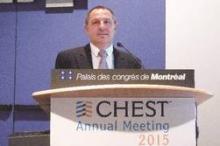MONTREAL – A relatively new system for delivering noninvasive respiratory support, high-flow nasal cannula therapy, appeared well suited to ventilation therapy for coronary care unit patients, according to a single-center experience in New Zealand with 497 adult patients.
“The high-flow nasal cannula largely replaced noninvasive ventilation in our CCU patients with no change in escalation rates or mortality. The high-flow nasal cannula should be considered a first-line treatment in this setting,” said Dr. Troy S. Browne at the annual meeting of the American College of Chest Physicians.
He and his associates at Tauranga (New Zealand) Hospital compared their experience using standard noninvasive ventilation on 249 CCU patients who needed respiratory support during May-November 2012 with 248 patients who received ventilation with a high-flow nasal cannula once it became the default strategy in the coronary care unit. The high-flow nasal cannula produced similar outcomes while being “better tolerated and less of a burden for the nursing staff to manage,” said Dr. Browne, an anesthesiologist and critical care medicine specialist at Tauranga Hospital. A key feature of the high-flow nasal cannula system is the warmed and humidified mix of oxygen and air that it pumps.
“If you run a nasal cannula without this, you dry out the patient’s nose at 5 or 6 L/min, and it’s very uncomfortable. But I’ve worn a high-flow nasal cannula with 30 L/min flow and I couldn’t tell I was wearing it,” commented Dr. Thomas Fuhrman, chief of anesthesiology at the Bay Pines (Fla.) VA Healthcare System. “It’s high enough flow to open the lungs but much better tolerated” than standard noninvasive ventilation, Dr. Fuhrman said in an interview. Patients can open their mouths, swallow, and eat while wearing the high-flow nasal cannula, he noted.
“This report is a step forward and will help spur adoption” of the high-flow nasal cannula, Dr. Fuhrman predicted. Many cardiologists are not yet aware of it as it’s usually placed by intensivists. Over time, additional indications for the device will develop, he added.
The specific system used in Tauranga Hospital”s coronary care unit is the Optiflow high-flow nasal cannula along with the Airvo pumping system, both marketed by Fisher & Paykel Healthcare. During the 6 months preceding November 2012, 107 of 249 (43%) CCU patients underwent noninvasive ventilation during the first 40 hours following CCU admission. During the subsequent period ventilation started on 67 of 248 (27%) during the first 40 hours. Of those, 60 (90%) received sufficient treatment with a high-flow nasal cannula, while 7 (10%) required standard noninvasive ventilation. Patient outcomes during the two periods were similar.
A more definitive comparison of noninvasive ventilation and high-flow nasal cannula treatment requires a prospective, randomized study, Dr. Browne said.
On Twitter @mitchelzoler



